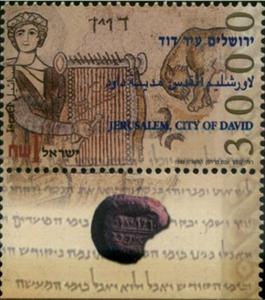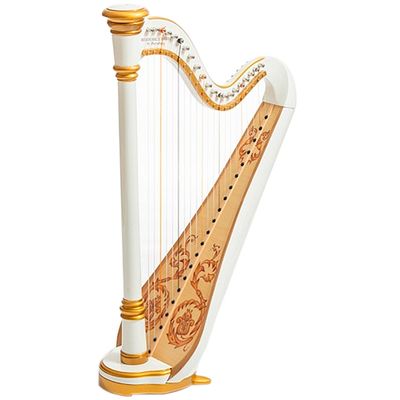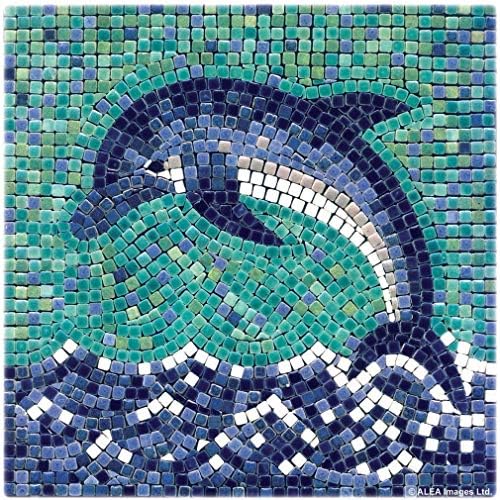Stamp with Collectible Margin: King David playing Harp (mosaic pavement, Gaza Synagogue) (Israel 1995)
King David playing Harp (mosaic pavement, Gaza Synagogue) (Israel 1995)
04 September (Israel ) within release 3000th Anniversary of City of David (Jerusalem) goes into circulation Stamp with Collectible Margin King David playing Harp (mosaic pavement, Gaza Synagogue) face value 1 Israeli new shekel
| Stamp with Collectible Margin King David playing Harp (mosaic pavement, Gaza Synagogue) in catalogues | |
|---|---|
| Michel: | Mi: IL 1342T |
| Stamp Number: | Sn: IL 1245T |
| Yvert et Tellier: | Yt: IL 1287T |
| Stanley Gibbons: | Sg: IL 1286T |
Stamp with Collectible Margin is square format.
Also in the issue 3000th Anniversary of City of David (Jerusalem):
- Stamp with Collectible Margin - Aerial view of Knesset (parliament) face value 1.80;
- Stamp with Collectible Margin - Illustration of Jerusalem from 19th-c. map by Rabbi Pinie face value 1.50;
- Stamp with Collectible Margin - King David playing Harp (mosaic pavement, Gaza Synagogue) face value 1;
Stamp with Collectible Margin King David playing Harp (mosaic pavement, Gaza Synagogue) it reflects the thematic directions:
An anniversary is the date on which an event took place or an institution was founded in a previous year, and may also refer to the commemoration or celebration of that event. For example, the first event is the initial occurrence or, if planned, the inaugural of the event. One year later would be the first anniversary of that event. The word was first used for Catholic feasts to commemorate saints. Most countries celebrate national anniversaries, typically called national days. These could be the date of independence of the nation or the adoption of a new constitution or form of government. The important dates in a sitting monarch's reign may also be commemorated, an event often referred to as a "Jubilee".
The harp is a stringed musical instrument that has individual strings running at an angle to its soundboard; the strings are plucked with the fingers. Harps can be made and played in various ways, standing or sitting, and in orchestras or concerts. Its most common form is triangular in shape and made of wood. Some have multiple rows of strings and pedal attachments.
King is the title given to a male monarch in a variety of contexts. The female equivalent is queen regnant (while the title of queen on its own usually refers to the consort of a king). In the context of prehistory, antiquity and contemporary indigenous peoples, the title may refer to tribal kingship. Germanic kingship is cognate with Indo-European traditions of tribal rulership (c.f. Indic rājan, Gothic reiks, and Old Irish rí, etc.) In the context of classical antiquity, king may translate Latin rex or either Greek archon or basileus. In classical European feudalism, the title of king as the ruler of a kingdom is understood as the highest rank in the feudal order, potentially subject, at least nominally, only to an emperor (harking back to the client kings of the Roman Empire). In a modern context, the title may refer to the ruler of one of a number of modern monarchies (either absolute or constitutional). The title of king is used alongside other titles for monarchs, in the West prince, emperor, archduke, duke or grand duke, in the Middle East sultan or emir; etc. Kings, like other royalty, tend to wear purple because purple was an expensive color to wear in the past.
A mosaic is a pattern or image made of small regular or irregular pieces of colored stone, glass or ceramic, held in place by plaster/mortar, and covering a surface. Mosaics are often used as floor and wall decoration, and were particularly popular in the Ancient Roman world.
A musical instrument is a device created or adapted to make musical sounds. In principle, any object that produces sound can be considered a musical instrument—it is through purpose that the object becomes a musical instrument. A person who plays a musical instrument is known as an instrumentalist. The history of musical instruments dates to the beginnings of human culture. Early musical instruments may have been used for rituals, such as a horn to signal success on the hunt, or a drum in a religious ceremony. Cultures eventually developed composition and performance of melodies for entertainment. Musical instruments evolved in step with changing applications and technologies.




